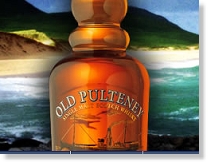Old
Pulteney Single Malt Scotch Whisky
Pulteney
Distillery
Huddart Street, Wick
Caithness KW 1 5BA Scotland
Tel: +44 (0)1955 602 371 / Fax: +44 (0)1955 602 279
 Established
in 1826 in Wick, Pulteney Distillery is the most northerly
distillery on the Scottish mainland and at that time was only
accessible by sea. The barley was brought in Established
in 1826 in Wick, Pulteney Distillery is the most northerly
distillery on the Scottish mainland and at that time was only
accessible by sea. The barley was brought in
by sea, the whisky shipped out by boat and many of the distillery
workers were also employed as fishermen. Sadly the herring
fishing industry is no longer part of daily life in Wick but
Pulteney Distillery continues to operate, distilling one of
the finest Highland malts available.
The
heritage of Wick is strongly portrayed in the presentation
of Old Pulteney. The distinctive still shaped bottle is screen
printed with a traditional Wick herring drifter. These boats
were used to catch herring at the beginning of the 19th century.
The first herring drifter to sail into Wick was ‘The
Content’.
The distinctive Old Pulteney bottle is presented in a specially
created oval canister, which is printed inside and out to
give a premium product finish.  The
canister bears the traditional Wick herring drifter on the
front with striking rustic shades in the background. An ancient
map of the north of Scotland is printed on the inside, pinpointing
Pulteney Distillery – the most northerly distillery
on the Scottish mainland. The
canister bears the traditional Wick herring drifter on the
front with striking rustic shades in the background. An ancient
map of the north of Scotland is printed on the inside, pinpointing
Pulteney Distillery – the most northerly distillery
on the Scottish mainland.
The consistently Highland malt produced at Pulteney is much
admired by connoisseurs, who refer to it as "the manzanilla
of the north" recalling a particular type of sherry which
also matures at the sea. Apart from the salty air, no doubt
the curious design of the copper pot-still plays an important
role in shaping the character of this superb malt whisky.
|
Courtesy
of Old Pulteney Distillery |
OLD
PULTENEY 12 YEAR OLD
SINGLE MALT SCOTCH WHISKY |
OLD
PULTENEY 21 YEAR OLD
SINGLE MALT SCOTCH WHISKY |
Appearance:
Deep amber, red gold (with a slight pink hue).
Nose: Medium to high intensity and complexity.
Dry with a hint of sea air.
Taste: Dry, medium bodied and smooth with a clean,
dry finish: faintly salty with a slight sherry note Tasting
Notes by Old Pulteney Distillery |
Appearance:
Golden amber with straw highlights
Nose:
Full bodied with traces of fruits (apples and pears); slightly
fragrant with spicy overtones
Taste:
Sweet to start with a light fruitiness; hints of honey and vanilla
followed by a dry finish
Tasting
Notes by Old Pulteney Distillery |
Pulteney
Whisky Distillery

The Pulteney Whisky
Distillery |
A
visit to Caithness and Wick is not complete without a visit
to the Pulteney Distillery. Telephone the number below or
call in to arrange a tour. You will be taken on a voyage of
discovery,a journey, back in time to discover the history
and art of Scotch Whisky making. A full range of goods and
products are available for sale in the distillery shop.
When you step into the distillery itself it is like stepping
back in time, due to the fact that the traditional ways of
operating are still used today. You will not see any computers
or electronic gadgets just Stillmen and Mashmen that have
a great knowledge of the whisky making process and a great
affection for the Pulteney they produce for others to enjoy.
Even in the stillhouse modern condensers have been frowned
upon and the traditional worm tubs are still used. These condense
the spirit at a snails pace as it winds around up to 90 metres
of copper pipe before ending up returning to the stillhouse
via the highly polished brass spirit safe. Here it sits in
a vessel until the stillmen /mashmen have time to put it in
the finest oak casks, then off to the warehouse where it rests
and matures for 12 years. Old Pulteney Single Malt Scotch
Whisky is then made available so you can all savour the uniqueness
of the Pulteney distillers caringly created Dram.
Pulteney Distillery Visitor Centre
Pulteney Distillery
Huddart Street
Wick Caithness
KW 1 5BA Scotland
Tel: +44 (0)1955 602 371
Fax: +44 (0)1955 602 279
History Timeline
1589 Wich was granted Royal Burgh status.
1665 The population of Wick was around six
hundred. .
1729 William Johnstone was born. Later in
life, he married a wealthy from Bath and adopted her name,
which was Pulteney. Johnstone was a "herring baron"
and a founding member of the British Fisheries Society. His
vision of a vast modern harbour capable of anchoring a thousand
boats and of attracting a settlement of Dutchmen, drove the
project forward. The British Fisheries Society commissoned
Thomas Telford, the famous Scottish engineer, to build the
harbour and the town. Telford was also responsible for building
the lade which carries water from Loch Hempriggs to Pulteney
Distillery.
1805 The first bridge in Wick was completed,
coinciding with the year of the Battle of Trafalgar and the
death of William Johnstone Pulteney.
1811 The harbour was completed at a cost
of £14,000. Telford planned a new village and the whole
area was named Pulteneytown after Sir William Pulteney. Bonnie's
Prince Charlie's failed revolution was kind to Wick. It was
money confiscated from Jacobites Chiefs which paid Telford
to build the harbour, the bridge and the new town of Pulteney,
harnessing the herring season and allowing Wick to develop
from a poverty stricken, coastal village to a thriving industrial
town.
1822 The Illicit Distillation (Scotland)
Act was introduced.
1826 Pulteney Distillery was founded by James
Henderson. Henderson was already an accomplished distiller
with 30 years experience further inland. After the The Illicit
Distillation (Scotland) Act in 1822, his small pot distillery
at Sibster was closed down. Henderson moved closer to the
sea, due not only to the distilling laws, but also because
of the increasing demand for his whisky from the provincial
towns of Scotland. The only means of transport to the south
was by sea via the port of Wick.
1830 Wick was being augmented by an influx
of 7000 workers.
1850 The herring fleet in Wick reached its
peak to one thousand boats. When all were in the harbour,
it was possible to cross dry-shod from one pier to another.
The itinerant workforce sought lodgings where they could find
them and at times ten or twelve were crammed into one room.
The unsanitary conditions resulted in outbreaks of disease.
Typhoid, smallpox and cholera were common.
1920 Pulteney Distillery was sold to James
Watson & Co Ltd Dundee who were subsequently acquired
by John Dewar & Sons Ltd.
1925 Pulteney Distillery was passed into
the hands of DCL.
1930 Pulteney Distillery closed as the whisky
industry entered into a difficult period.
1947 Prohibition was lifted.
1950 Herring fishing finally ceased at Wick.
1951 Production resumed at Pulteney, under
the new ownership of Robert Cumming, a Banff lawyer, who also
acquired Balblair Distillery
in Tain.
1955 Pulteney Distillery was sold to Hiram
Walker & Sons Ltd.
1995 Pulteney Distillery was purchased by
Inver House Distillers.
1997 Old Pulteney 12 Year Old Single Malt
Scotch Whisky was launched in the UK.
2003 The town of Wick remains an important
white fishing port. Seine net boats go far afield on week-long
voyages, across the North Sea to Norway and Denmark or west
into the Atlantic towards Rockall. Foreign vessels frequently
call at Wick to land fish or seek stores and repairs.
To many people, the name Caithness is synonymous with glass
- smoky tumblers, elegant lilac vases or intricate paperweights.
But nestling snugly in the quiet, urban confines of Pulteneytown
- there is a distillery.
Pulteney Distillery continues to distill the finest Highland
malt whisky using the same traditional techniques passed down
from the 19th century. The distillery has two stills, one
wash still and one spirit still, producing approximately 1
million litres of whisky a year. The spirit still is very
unique in shape due to there being no actual head and swan
neck. This is due to the still being delivered and being too
tall for the stillhouse. The manager at the time instructed
the coppersmith to cut the top off thus creating the unique
shape, often described as looking like a smugglers kettle. |
Courtesy
of Old Pulteney Distillery |
|